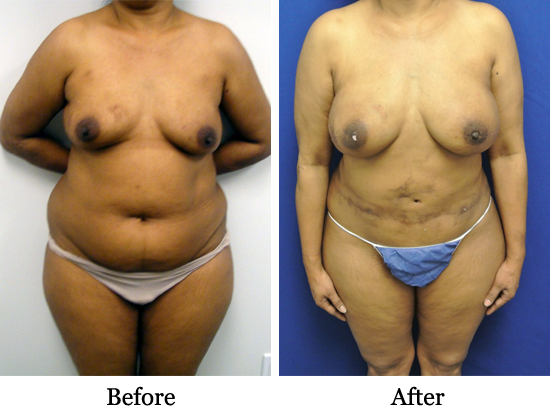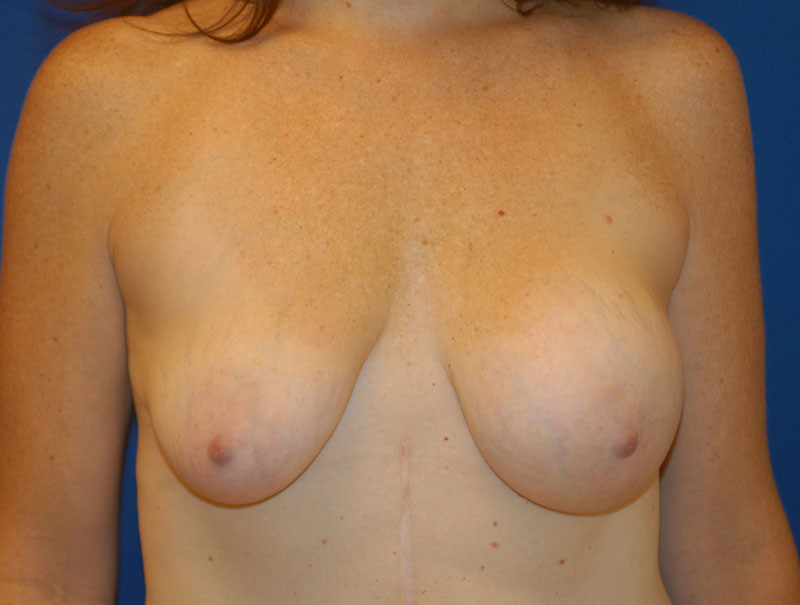Her Breasts Interfered With Her Daily Life
Every woman wants nice breasts, but when yours are 44G, and you’re only 5’2”, they’re not usually your best friends.
Read why one woman finally made the decision to downsize.

Every woman wants nice breasts, but when yours are 44G, and you’re only 5’2”, they’re not usually your best friends.
Read why one woman finally made the decision to downsize.

FOF Joan*, 61, has had “large breasts” her entire life. (Or at least, since puberty.) “When I was younger, it was great,” she says. “I had a phenomenal figure. They were a solid D cup—high and full… the best accessories I could ask for!” But as Joan got older, they started getting… less great. “By my 50s, I was up to a 34 DDD, and I just didn’t like the way they looked any more.” Although Joan’s weight was the same as ever—”I’ve always worn a size 8”—her breasts seemed too large—and saggy. “I had deep grooves in my shoulders from where my bra straps dug in,” she explains. “And I felt self-conscious.”
*Name changed to protect privacy.

Breast reduction and lift performed by Dr. Friedlander.
![]()
So when one of Joan’s interior design clients got a breast reduction, Joan peppered her with questions. “She looked fabulous,” Joan says now. So I got her doctor’s card.” She went to see Dr. Friedlander that March, just for a consult. “After two hours in her office, I booked the surgery that day,” she says. Here, Joan talks about her procedure, the aftermath, and what she’d tell other FOFs about breast reduction surgery.

Not all breast enhancement procedures are focused on increasing cup size. Instead, many women opt for breast reduction surgery to resolve physical discomfort. The concerns over larger breasts aren’t limited just to physical frustrations either; larger breasts can also be a source of emotional distress for many women. Can breast reduction actually improve your quality of life along with physically decreasing breast size?
The Impact of Large Breasts
Many women with overly large breasts would not agree that ‘bigger is better.’ The weight of the average breast is just over one pound, while the average breast weight removed during reduction surgery is around 1000g per side, or about two pounds per breast. That’s a lot of extra weight to carry around all day.

Julia on the beach post-op.
![]()
Julia*, 55, doesn’t cover up at the beach. But this wasn’t always the case. “I was looking in a mirror and my boobs were just hanging there,” this flight attendant and mother of three recalls thinking, about two years ago. Julia knew working out and dieting would not resolve this issue, so she decided surgery was “the perfect choice.” It was an opportune time for her to have this done, as her skin was “already stretched out” with “deflated” breasts and a saggy tummy from three C-sections. After extensively discussing her options with Dr. Jeffrey Ditesheim, Julia scheduled her surgery.
*Name changed to protect privacy.

Diep flap breast reconstruction performed by Dr. Lotempio.
![]()

How can a woman determine the right option for breast reconstruction after a mastectomy?
First, she should learn about all the options. There are variables like recovery time and breast size that may dictate one option over another for her but the best way to make a decision is to meet with a breast reconstruction surgeon.
What are the options available?
There are two main options. The first uses artificial implants such as silicone. Sometimes this can be risky–like on a patient that is having radiation. Implants don’t really like radiation. The other option, which I specialize in, uses autologous tissue. In other words, I use tissue from the patient’s own body to create a breast.
Is silicone still used for implants?
It is FDA approved for breast reconstruction.
What are the most common procedures you perform?
The DIEP (Deep Inferior Epigastric Perforator) Flap, the SGAP Flap (Gluteal Artery Perforator) Flap and the PAP (Profunda Artery Perforator) Flap. Each has a funny little acronym.
Tell me about the procedures.
For the DIEP flap, we take skin and fat from the abdomen and give you a tummy tuck, basically. We connect it to the blood supply in the chest wall and then we sculpt it and make a beautiful breast. I don’t take any muscle because we need muscles to move. The PAP flap is using the skin and fat from the back of your thigh which I call the banana roll (the fat right under the buttocks which no matter if we diet or exercise we can never get rid of it). We transfer it to the chest and connect it to the vessels in the chest. You end up with a posterior thigh lift. The SGAP takes the upper or lower buttocks skin and fat.
Click through the slideshow below to see an illustration of a DIEP flap procedure.
[portfolio_slideshow]![]()
Can the patient choose which part of the body they want to take tissue from?
The part of the body I use depends on the body of the patient. For instance, for someone who has had children and has a little extra belly fat, the abdomen is a very good choice. If the patient does not have adequate abdominal tissue, we might use tissue from the thigh or buttocks.
How come we’ve only seen procedures like this in the past twenty years or so?
The advent of high-resolution microscopes has made these procedures possible.
Are these procedures unique to your practice or do other surgeons perform them?
There are other doctors that do the DIEP, SGAP and PAP flaps, but I’m one of only a handful.
How long to the procedures take?
Usually between four to six hours. Some hospitals take a little longer. You are under general anesthesia. The day after surgery the patient can walk around, they don’t have IVs, they can eat. The recovery can be two days to a week, depending on the patient.
Does insurance cover these kinds of breast reconstruction after a mastectomy?
Yes, there was a federal law passed in 1998 that mandates insurance companies which cover mastectomies to cover reconstruction, as well.
![]()
.

LoTempio Plastic Surgery for Women
630 3rd Avenue, Suite 601
New York, New York 10017
Tel: (212) 427-2020
Toll Free: 1-866-719-DIEP
Fax: (917) 591-7702
www.lotempioplasticsurgery.com
![]()
![]()

Is there an advantage going to a woman plastic surgeon for breast augmentations or lifts?
I hear from patients every week that they feel more comfortable talking to women doctors than with male surgeons. They say they can more easily express themselves and be understood. We can also identify with them and with the changes in their bodies. For example, some male surgeons think every woman should get implants. In some cases they also tell patients how big they should be.
How does a woman decide whether she should have implants or just a breast lift?
Some women are small and know they need implants to be bigger. But if you’re wearing a C cup, you’re filling it out and you think it looks pretty good, you probably should just have a lift.
Are there many female plastic surgeons?
No, women account for only 10 percent of all plastic surgeons.
Why?
I am sure there are many factors. Traditionally, there’s been a prejudice against women in the world of general surgery. We weren’t considered tough enough to go through the grueling surgery training programs.
How grueling?
I studied general surgery for five years, followed by a two –year residency program in plastic surgery and then a six-month fellowship in breast surgery.
Why did you choose breast surgery as your specialty?
It’s creative and I find it rewarding to deal with so many different patients. We often have interaction afterwards since I see my breast patients for yearly follow-up visits. I also believe in specializing. I don’t do rhinoplasty. However, I do injectables, facelifts, neck lifts and eyelid surgery (blepharoplasty).
What advice do you give FOF women when choosing a plastic surgeon?
Don’t look for reviews on Google and don’t imbue doctors with abilities they don’t have. If your friend had a beautiful facelift by a doctor who is genius at facelifts that doesn’t mean he or she is a genius at performing breast implants. Talk to some of the doctor’s other patients and absolutely ask a surgeon about her background and training. Someone may have trained at an excellent institution for general surgery but has only a mediocre reputation in plastic surgery. Find out also about their breadth of experience. I’m 50, so I have a great deal of experience in breast surgery.
Once we choose a doctor, should we leave everything in her hands, so to speak?
Before your surgery, you should understand exactly what the surgeon intends to do. It’s a little scary when I read online sites, such as www.Realself.com, where doctors answer questions posted by patients. Patients sometimes indicate they’re going into surgery in a few days without any idea what’s going to happen.
Give an example of what can happen if you don’t do enough research on a surgeon or on the procedure you’re about to have.
Let’s say a woman over 60 wears a C cup and has lots of volume, but she’s lost volume in the upper half of her breasts due to gravity. It’s not enough to simply work on the drooping skin because it will start drooping again before too long. A top surgeon will work with the internal tissue so the lift lasts more than a couple of years. Sometimes I insert Strattice (a piece of sterilized pig skin) into the breasts, to reinforce the lift, which can help prolong the longevity of the result. Not all plastic surgeons have experience with advanced breast surgery techniques.
Are many FOF women having work on their breasts?
Breast reductions are quite commons among women who are 60+. They tell me they’ve always wanted smaller breasts, but their father or husbands didn’t want them to do it. The surgery totally changes their lives.
That’s exciting, but many women who’d love to have breast surgery can’t afford to do it. It’s so costly and medical insurance doesn’t pick up the cost.
It is a common misconception that insurance doesn’t cover breast reduction, when, in fact, it does in the majority of cases. We try to accommodate patients who don’t have insurance or whose insurance will not cover the procedure, as well as those who prefer to use a plastic surgeon who doesn’t accept insurance. We will let a patient pay over time. I also like a financing program that Care Credit offers for plastic surgery. The patient can pay off the loan over 12 months without interest.
![]()
.

969 Madison Avenue
New York, New York 10028
Tel: (212) 860-0670
www.drpfeifer.com
Click here to view Dr. Pfeifer’s patient before and after.
![]()
——————————————————————————————————————————————
 What is the main reason that women choose to have breast augmentation or lift surgery?
What is the main reason that women choose to have breast augmentation or lift surgery?
Women between the ages of 18 and 35 want larger breasts to feel more feminine. Perky, full but not overly large breasts provide them with the ability to fill out a dress or a bikini, which increases their self-confidence.
Starting in their mid to late 30s, women notice that their once-perky breasts have drooped with age, often times after having children. Their breasts also may lose fullness, as a result of post-pregnancy changes.
Starting in their 50s, women will often notice a change in breast size compared to their younger years. This is due to age and gravity as well as to changes associated with menopause. Much of the elasticity has been lost and the breasts don’t have the fullness or bounce they once had.
Are more FOF women having breast surgery? If so, why?
Yes, noticeably more, perhaps in the neighborhood of a 20 percent increase. Breast enhancement surgery is not just for the rich and famous, actresses or models. It can benefit women of all backgrounds and at different stages of life. Competition, the economic downturn and financing plans have made plastic surgery of the breast much more affordable to women of almost all income levels.
How does a woman decide whether she should explore her options?
If a woman would rather have the lights off than on when she is topless, it may be time to consider a consultation with a plastic surgeon.
How do you perform lift surgery?
Breast lifts are performed on women of all ages. The incision may be made just around the areola, around the areola and down the center of the bottom part of the breast (a “lollipop lift”) or around the areola, down the center and at the infra-mammary crease (where an underwire would sit). The incisions used will depend on the amount tissue that needs to be lifted and/or removed.
And what happens with implant surgery?
A breast implant can be placed in front of or behind the muscle. It can be placed through an incision around the areola, under the breast (in the infra-mammary crease), or under the armpit (trans-axillary). If a breast lift is being performed at the same time, there is no need for any additional incisions beyond those being used for the lift itself. The surgery is performed on an outpatient basis in an accredited facility.
What are implants made of?
Breast implants have a silicone shell which is filled with sterile salt water (saline) or a silicone gel. In the United States, three companies manufacture both types of breast implants: Allergan, Mentor (a division of Johnson & Johnson) and Sientra, whose implants recently received FDA approval
What’s the difference?
Silicone gel implants feel, look and behave more like a natural breasts than saline implants. In general, silicone gel implants also are more durable than saline implants.
What’s happened with the silicone safety issue since 1992, when it was thought leaks from these implants could lead to cancer and they were pulled off the market?
Breast implants are safe and approved by the FDA. However, saline or silicone gel breast implants can develop leaks. The odds of rupture are 1 percent per year per implant. In most cases, it is best to place breast implants under the muscle, which protects and camouflages them better and minimizes any interference with a mammogram.
What if you’re one of the unlucky women?
If a woman has a ruptured breast implant, the implant should be removed promptly. It may be replaced with a new implant. If a woman desires, she may use this opportunity to select a new implant type or size compared to the one that ruptured. To the best of our knowledge, there is a very little chance that a woman’s health will be affected by a leaking implant.

A ruptured saline breast implant.
How can someone tell if her implants are leaking?
The breast will decrease in size if a saline implant has ruptured. It may be more difficult to detect a rupture with a silicone gel implant. Whether or not a woman has implants, she should perform monthly self breast examinations to detect cancer, as well as have her breasts examined by her doctor at least once a year. If there is any concern that a silicone gel breast implant has ruptured, a woman should see her plastic surgeon.
How does a woman decide what size implant is ideal for her?
Implant size is a personal choice. To start, a woman can put on an unpadded bra and a tight T-shirt. We then insert breast implant sizers to determine what looks and feels best for her. Breast and chest measurements are taken to ensure the implants are within an appropriate range for that patient.
How does a woman decide which surgeon to use?
Make sure the plastic surgeon has completed an accredited plastic surgery residency. It’s a bonus if he or she has completed additional training, known as a fellowship. Check that the surgeon has hospital privileges for plastic surgery. If the doctor is operating outside of the hospital, make sure the facility is accredited. Ask to see before and after photos as well as to speak or meet with patients who have undergone surgery like the one you are considering.
I am a member of the medical staff at Lenox Hill Hospital, Manhattan Eye, Ear & Throat Hospital, and the New York Eye and Ear Infirmary. I also operate at the Center for Specialty Care as well as in our accredited outpatient surgery center located in our office. Besides completing a plastic surgery residency, I have completed two fellowships: one at Georgetown University Hospital in aesthetic and breast plastic surgery, the other affiliated with Stanford in advanced facial plastic surgery.
Is the surgery dangerous?
Plastic surgery that is performed in an accredited facility is generally ve safe. I work with an experienced team that includes board certified anesthesiologists, which enables me to perform Rapid Recovery Breast Augmentation under intravenous sedation, not general anesthesia. This means less risk and faster recovery for my patients. Women walk out of the office a few hours after surgery feeling like they have a little pressure on their chest.
The best question for last. What is the cost?
The cost for a breast augmentation starts around $5,000. The cost of the breast lift varies and depends on the amount of work that needs to be done. A breast lift starts around $7,500. A breast lift with an augmentation costs around $10,000.
Why is this surgery so costly?
You have to consider all the costs, including the anesthesiologist, the operating room, the implants, the staff, and the surgeon’s fee.
(Editor’s note: A good paint job on a modest size New York apartment costs well over $7,000, so this is pretty good price to give your breasts a fresh new look.)
——————————————————————————————————————————————
Plastic Surgery Institute
60 East 56th Street, 2nd floor
NYC, NY 10022
Tel: (212) 688-5882
Click here to view Dr. Schaffner’s patient before and after.
——————————————————————————————————————————————

![]()

What are the best options for a saggy neck and jowls?
Good question, as this is the biggest giveaway of an FOF’s age. Traditionally, FOFs have gotten facelifts as a solution to this problem. However, facelifts can be invasive and have a long recovery time. For the past four years, I’ve been performing a procedure called the “Natural Lift” as a way to avoid or postpone a facelift. I remove a teaspoon of jowl fat and 2 tablespoons of neck fat. It’s a 45-minute procedure, done with local anesthesia and requires minimal recovery time. Consider it the ultimate cheat and prevention for aging.
What are the latest innovations in liposuction? Can you have liposuction anywhere and everywhere?
Yes, you can. This past year two new non-invasive devices have come onto the market that melt fat away when you use them over the skin. They allow you to shrink even the thinnest layers of fat cells in parts of the body that used to be difficult to reach through liposuction cannulas (tools). The device I use is called VASER Shape which feels like a hot stone massage.
What type of implant is better or which do you recommend: Saline or silicone?
I prefer silicone and implant them in my patients 99% of the time. With silicone, the deflation rate is low and they feel more natural. Most women getting augmentation have very little breast tissue and the breast is made up of mostly the implant. In the rare cases where someone with bigger breasts (for example a size B) wanted to go to a size C, then I might use saline.
I’ve heard of a “vampire facelift,” what is this?
Despite its name, the vampire facelift is actually a non-surgical cosmetic procedure, rather than a facelift. It uses the patient’s own blood, which is rich in antioxidants and collagen, to make the skin more radiant. Often times, people combine this treatment with fillers for the ultimate facial rejuvenation. The vampire facelift is the same treatment top athletes such as Tiger Woods have had done to their joints to promote healing and increase vascularity. The way it works is blood is drawn, then the Platelet-Enriched Plasma (PRP) is separated and concentrated. The PRP is essentially tattooed back into the middle layer of the skin to promote radiance. My favorite protocol of this procedure uses the Dermapen. (For more about Dermapen, read below.)
As a teen, I had very bad acne and now I have scars, pitting and large pores. What do I do?
My favorite new device to reverse damage from acne, is the Dermapen. It stimulates collagen in the middle layer of the skin, plumping acne pitting. It’s the only therapy that helps with deep pitting. It can level the top edge of the pit to the bottom. Also, it’s great for fine lines and wrinkles on the upper lip. It can be used on all skin types, is much less expensive than laser devices and does not cause heat damage to the surrounding, healthy skin.
Do you build up resistance to Botox to the point that it stops working?
First of all, there are 3 neuro-modulators on the market today—Botox Cosmetic, Dysport, and Xeomin—each have their own unique properties. You cannot build up a resistance to neuro-modulators. However, the more you use them, the less you need them because you train your face not to make certain movements. For this reason, it’s important to get treatments regularly. I have been using neuro-modulators on myself for 12 years and now I only need to get it done twice a year, whereas when I started I was getting four treatments a year.
![]()
114 East 61st Street
New York, New York 10065
Tel: (212) 421-3400
Fax: (212) 421-3435
www.drsharongiese.com
Click here to view Dr. Giese’s patient before and afters.
![]()